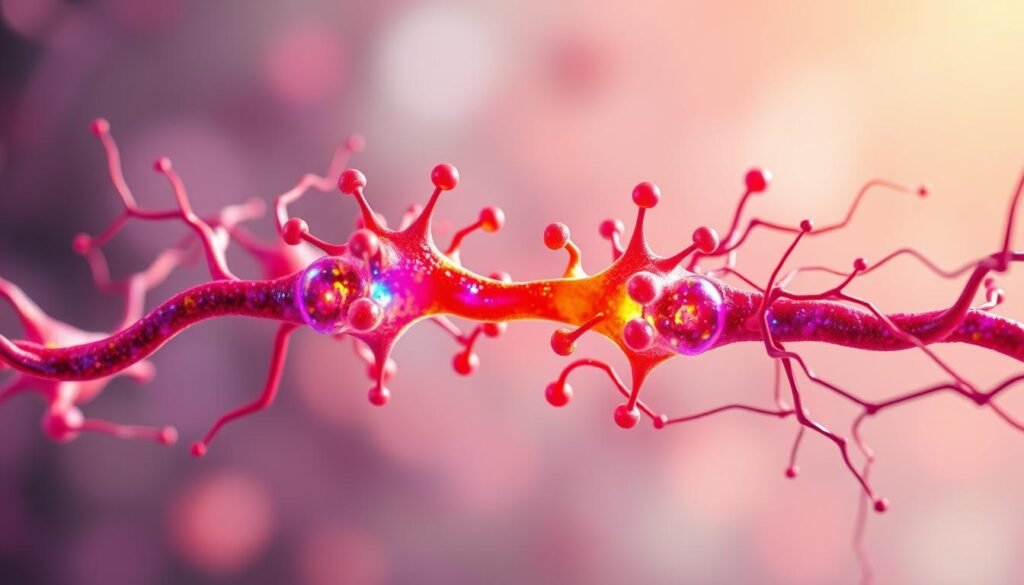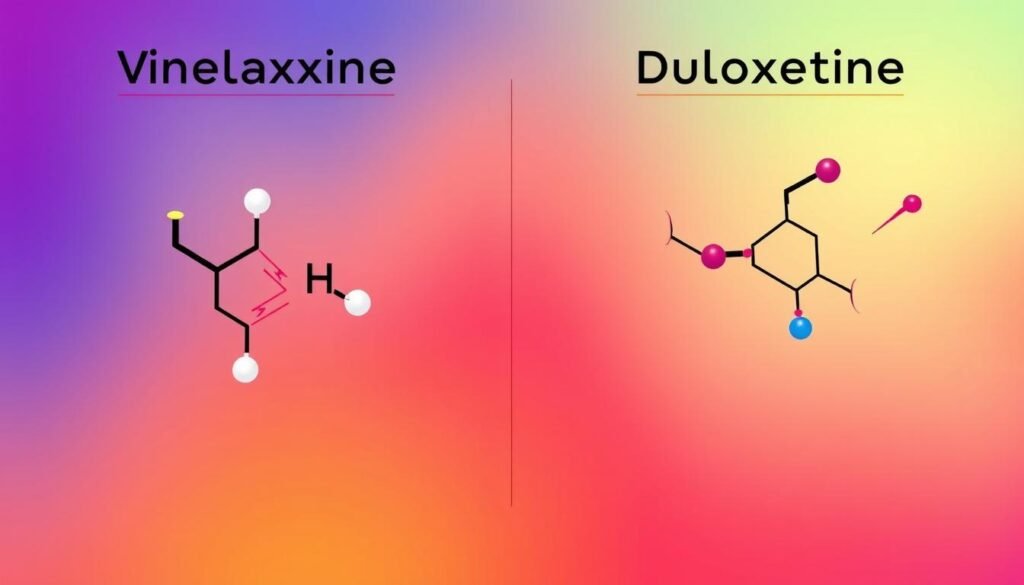Did you know the FDA approved drugs called SNRIs for depression? Venlafaxine (Effexor) and Duloxetine (Cymbalta) are two of them. These meds started in the 1990s and early 2000s. They help with mood disorders, anxiety, and chronic pain. They are key in making mental health better for millions.
Venlafaxine and Duloxetine stand out because they work on both serotonin and norepinephrine in the brain. This dual action is key for treating depression. You can learn more about how they work and why doctors prescribe them here.
Let’s dig deeper into how Venlafaxine and Duloxetine work. We’ll look at their benefits and side effects. It shows how important they are for dealing with mental health issues.
Key Takeaways
- Venlafaxine and Duloxetine are leading examples of SNRIs used for treating depression and anxiety.
- Approved in the U.S. since the 1990s and 2000s, these medications enhance mood and alleviate pain.
- SNRIs target both serotonin and norepinephrine, offering a multi-faceted approach to mental health.
- Despite their effectiveness, potential side effects require careful monitoring during treatment.
- Combining SNRI therapy with psychotherapy can lead to better outcomes for those suffering from depression.
Introduction to SNRIs
Serotonin-norepinephrine reuptake inhibitors (SNRIs) are a key type of antidepressants. They improve mental health by aiming at serotonin and norepinephrine in the brain. These drugs help with major depression and anxiety disorders. They are as good as SSRIs but also help with chronic pain.
SNRIs work by stopping the reuptake of serotonin and norepinephrine. This helps ease depression and anxiety symptoms. Drugs like duloxetine and venlafaxine are top choices for generalized anxiety disorder in adults. They play a big role in making mental health better.
Some SNRIs also help with pain conditions like fibromyalgia and diabetic neuropathy. People with liver or kidney problems may need different doses for safety and effectiveness. For more info on the benefits and risks of SNRIs, click here.
Understanding Serotonin-Norepinephrine Reuptake Inhibitors
Serotonin-norepinephrine reuptake inhibitors, known as SNRIs, are key in treating mood disorders. They block the reabsorption of certain neurotransmitters in the brain. This action boosts the availability of serotonin and norepinephrine, critical for managing mood.
But SNRIs don’t just tackle depression. They also help with anxiety disorders and chronic pain, like nerve pain. Desvenlafaxine (Pristiq) and Duloxetine (Cymbalta), approved by the FDA, are known for their strong effects. They often work better than other medications in severe depression cases.
A table below provides a summary of key SNRIs available in the market:
| SNRIs | Common Uses | Brand Names |
|---|---|---|
| Desvenlafaxine | Depression | Pristiq, Khedezla |
| Duloxetine | Depression, anxiety, pain | Cymbalta, Irenka |
| Levomilnacipran | Depression | Fetzima |
| Milnacipran | Fibromyalgia | Savella |
| Venlafaxine | Depression, anxiety | Effexor XR |
SNRIs are vital in treating mood disorders because they address both emotional and physical symptoms. This includes treating depression-related pain. While reactions to these medications can differ, many people see an improved quality of life.

How SNRIs Work to Treat Depression
SNRIs, or serotonin-norepinephrine reuptake inhibitors, help those with depression and mood disorders. They boost serotonin and norepinephrine in the brain. This uplifts mood and energy. This makes SNRIs work well for people who don’t get better with SSRIs.
When SSRIs don’t cut it, doctors might move to SNRIs. They’re stronger against severe depression. SNRIs help with emotional and physical depression symptoms, like fibromyalgia pain.
SNRIs have their perks. Studies show they’re easier on the body than SSRIs, leading to better patient follow-through. They offer a broad spectrum of relief for many symptoms. Yet, there’s a catch. They come with a warning of possible suicidal thoughts in certain users.
The following table compares some important aspects of SNRIs and SSRIs:
| Factor | SNRIs | SSRIs |
|---|---|---|
| Mechanism of Action | Inhibits reuptake of both serotonin and norepinephrine | Inhibits reuptake of serotonin only |
| Effectiveness | More effective for severe depression and physical symptoms | Effective, particularly for anxiety |
| Common Side Effects | Excessive sweating, constipation, possible blood pressure increase | Weight changes, sexual dysfunction, dizziness |
| Tolerability | Generally better tolerated | Less tolerable in some cases |
| Potential Risks in Pregnancy | Possible withdrawal symptoms in the baby | Generally lesser known risks |

Knowing how SNRI treatment works helps patients and doctors choose wisely. SNRIs are a strong choice in mental health care today.
Examples of SNRIs: Venlafaxine and Duloxetine
Venlafaxine and duloxetine are important in the SNRI medication class. They’ve been recognized for over twenty years for treating conditions like depression and anxiety. Knowing about these meds helps patients and healthcare pros make better choices.
Overview of Venlafaxine (Effexor)
Venlafaxine, or Effexor, fights major depressive disorder, anxiety, and panic attacks. It’s shown success in short-term depression treatment. Effexor comes in various forms and strengths for patient needs. However, it’s linked to a risk of increased suicidal thoughts in young people when starting or changing doses.
Overview of Duloxetine (Cymbalta)
Duloxetine, also called Cymbalta, works like venlafaxine but also treats diabetic neuropathy and fibromyalgia. It helps with anxiety and depression. Duloxetine comes with similar FDA warnings about suicidal risks in the young. Both drugs are key for treating tough mental health issues. For more details on how they compare, check this comparison.

Clinical Indications for SNRIs
Serotonin-norepinephrine reuptake inhibitors (SNRIs) are key in treating mental health issues and managing pain. They are especially good for major depression, anxiety disorders, and various pain syndromes. These uses show how SNRIs can be important for treatment.
Approved Uses for Venlafaxine
Since 1994, Venlafaxine, or Effexor, has been used to treat psychiatric conditions. It’s mainly used for major depressive disorder, generalized anxiety disorder, panic disorder, and social anxiety disorder.
It has proven to be effective for these issues. Thus, it’s often chosen first for treating major depression and anxiety disorders.
Approved Uses for Duloxetine
Duloxetine, also known as Cymbalta, treats a wide range of conditions. Its uses include major depressive disorder, generalized anxiety disorder, fibromyalgia, diabetic peripheral neuropathy, and musculoskeletal pain.
Studies show it helps with major depression and anxiety. It also relieves chronic pain. This makes duloxetine valuable for both mental health and pain relief.
| Medication | Approved Clinical Indications |
|---|---|
| Venlafaxine | Major depressive disorder, generalized anxiety disorder, panic disorder, social anxiety disorder |
| Duloxetine | Major depressive disorder, generalized anxiety disorder, fibromyalgia, diabetic peripheral neuropathy, musculoskeletal pain |
Pharmacological Properties of Venlafaxine and Duloxetine
Venlafaxine and duloxetine have different effects that influence their use. These differences are key to understanding how they work in the body. They show why doctors choose one drug over another.
Venlafaxine mainly stops norepinephrine and serotonin from being taken back up by the brain. It favors serotonin more than norepinephrine. Duloxetine, on the other hand, affects both equally. This makes duloxetine better at improving mood and energy levels.
For venlafaxine to work well, higher doses might be needed. But duloxetine might cause fewer side effects even at low doses. This means patients may stop taking venlafaxine more often than some other drugs.
The following table shows important details about these medicines:
| Characteristic | Venlafaxine | Duloxetine |
|---|---|---|
| Inhibition Ki Value (NE) | 2480 nM | 7.5 nM |
| Inhibition Ki Value (5-HT) | 82 nM | 0.8 nM |
| Ki Ratio (NE:5-HT) | 30 | 9 |
| ED50 (NE inhibition in rats) | 54 mg/kg | 0.7 mg/kg |
| ED50 (5-HT inhibition in rats) | 2 mg/kg | 0.03 mg/kg |
| Common Side Effects | Higher rates compared to SSRIs | Higher rates compared to placebo |
This table helps us see the differences between the drugs. Knowing these key facts helps doctors decide the best treatment for depression and similar issues.
Side Effects and Cautions of SNRIs
It’s important to know the side effects and cautions of SNRIs like Venlafaxine and Duloxetine. These medicines help with depression and anxiety, but they have potential risks.
Common Side Effects
People on SNRIs might see some side effects. These include:
- Nausea
- Dry mouth
- Dizziness
- Headache
- Excessive sweating
- Constipation
- Changes in sexual function
- Loss of appetite
Usually, these side effects get better over time. Patients should talk with their doctors about any hard symptoms. This is key to staying healthy while on these meds.
Serious Risks and Considerations
SNRIs have some more serious risks too. Venlafaxine can raise blood pressure. Duloxetine might make liver problems worse. Stopping these meds too fast can cause withdrawal. This includes dizziness, headaches, flu-like symptoms, and mood swings.
Serotonin syndrome is another big risk. Its signs are:
- Nervousness
- Muscle issues
- Rapid heart rate
- High blood pressure
- Severe confusion
This condition is very serious and needs quick help. Watching closely is key for anyone on SNRIs. This is very true for young people, as these meds can up the risk of suicidal thoughts at the start or with dose changes.
| SNRI | Common Side Effects | Serious Risks |
|---|---|---|
| Venlafaxine | Nausea, Dry mouth, Dizziness | Increased blood pressure |
| Duloxetine | Headache, Constipation, Changes in sexual function | Exacerbation of liver issues |
In short, SNRIs can work well, but knowing about SNRI side effects is key. Patients must follow their doctor’s advice for safe treatment.
Comparative Efficacy of SNRIs and Other Antidepressants
When we look at SNRIs compared to SSRIs and tricyclics, there’s a noticeable difference. A review looked at 830 studies and chose 13 that were very thorough. These studies showed SNRIs, like venlafaxine and duloxetine, are really good at helping with ADHD and depression.
Duloxetine did especially well, reducing ADHD symptoms significantly more than venlafaxine. About the side effects, they mainly included things like nausea and sleepiness. However, these side effects were generally mild.
Venlafaxine was found to work better for women and helped more with attention issues. This suggests that how well treatments work can be different for each person. Compared to SSRIs and tricyclics, SNRIs might be a better choice in some situations.
SSRIs are usually the go-to for treating depression, but SNRIs could offer extra benefits for some people. It’s important to pick a treatment that matches the person’s specific needs. This highlights the importance of treatments that are tailored to the individual.